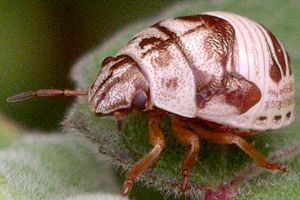
grasshopper
 grasshopper |
As with many aspects of our world, we are attracted to that which is most similar to us, and therefore comfortable, and tend to be repelled, or at least hesitant, when it comes to the strange or alien. So it is with life forms, even at their most attractive immature stages. Fawns, cubs and cygnets still sound engaging, even though they are wild animals. When it comes to tadpoles and nestlings, though, the feeling changes from an emotional one implying cuddling and petting to more of an intellectual curiosity. Baby fish move from the "pleasant admiration" end of the spectrum to the "practical exploitation" side with "fry." Reptiles don't even get enough attention to warrant a specific appellation; they are simply called hatchlings, which can mean anything that just broke out of an egg, and then later young snakes, young turtles, or young lizards. It becomes even more obvious when invertebrates are involved. Since we possess an internal skeleton, we like to think our condition is superior to those "lesser" creatures with no backbone. It is unlikely that anyone feels a protective parental instinct when confronted with labels such as larva or nymph. Some more specific terms are even worse, eliciting revulsion. One doesn't have to be very squeamish to be put off by the thought of spiderlings, grubs, or maggots. Even the young of the most universally attractive insects, butterflies, range from being neutral sounding "caterpillars" to despised "worms."
 shield bug |
Insects, and arthropods in general, are so different from mammals and birds that it actually sounds odd to even call them babies at all. Many people don't think of insects as animals. If they mention them at all, it is frequently in the context of "animals and insects," as if the two groups are mutually exclusive. Lists of wildlife, so popular in refuges, parks and preserves, usually feature mammals, birds, reptiles, amphibians, and fish. Only rarely do they include mollusks, annelids, or arthropods. Well, to set the record straight, insects ARE animals. They certainly are not plants or fungi.
The fact that insects undergo some drastic changes between hatching and maturity is both a boon and a drawback to their popularity with the general public. Because of some very obvious different forms, we HAVE come up with a small number of terms that are in the popular vocabulary and familiar to most people, such as inchworm, hornworm, woolly bear, chrysalis, and pupa. On the other hand, many immature forms look SO strange that they are nothing like the adults, and few people would recognize them as, well, anything that they could name. Nobody likes to be clueless, so there is already a built-in animosity when it comes to these frustrating faunal enigmas.
 praying mantis |
To compound the identification issue and ensuing confusion, there is the added problem of distinguishing an immature insect from an adult. While only adults have wings, there are also many species' adults lacking wings or that have them hidden when not in use. The number of insect species in any given area is mind-boggling, so there are likely to be many that are new to any particular person throughout their entire life. It is hard to convince even rational people that a tiny cicada is NOT a baby cicada just because another kind, which they have seen before, happens to be twice as big. Folks used to noticing only honey bees find it almost impossible to believe that some of the myriad tiny native bees are adults too. It's like saying a full grown meadow vole is a baby muskrat.
Perhaps the biggest hurdle to appreciating baby bugs is their size. We are fairly large animals, so looking at things that are the smallest form of already small creatures takes a bit of effort. Most insect eggs are miniscule, and the creatures that hatch out are not much bigger. Of course they grow, but it is within reason and they never reach the size of even a runty golden retriever.
In spite of all the disadvantages that baby bugs have when compared to kits or goslings, some of them really ARE rather cute. It's true that some are featureless grubs or worms that hold no appeal to our emotional side, but others have some of the same characteristics that makes any young animal endearing. A rather compact form with short antennae and legs, and big eyes on a big head (yeah, cute as a bug) make even efficient predators or garden pests look like good prospects for the next super-cuddly plush toy hit.